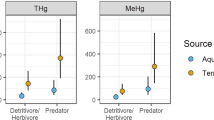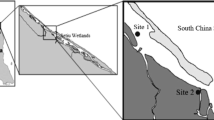Abstract
A widely recognized pathway for uptake and accumulation of organic contaminants by demersal fishes is through consumption of infaunal organisms (i.e., those having direct contact with contaminated sediments). Recent studies indicate that demersal fishes near a large sewage outfall in southern California consume larvae of a terrestrial fly, Clogmia albipunctata, which are entrained with the treated effluent and discharged to the ocean. Fly larvae consumption represents a possible method for accumulation of organic contaminants that is unique to marine fishes with non-selective feeding habits that occur near the ocean outfall. An estimated 37–138 kg (wet weight) of fly larvae are discharged daily during summer to the ocean via the Orange County Sanitation Districts (OCSD) wastewater outfall; winter discharges are expected to be lower due to lower production and temperature limitations of the fly life cycle. Fly larvae were present in the guts of ten demersal and pelagic fish species collected near the outfall between July 1993 and August 1998. The highest frequencies of fly larvae (up to 100%) occurred in the guts of white croaker, Genyonemus lineatus, and chub mackerel, Scomber japonicus. Because infauna are still abundant and diverse near the outfall, fly larvae consumption appears to represent a feeding preference instead of a response to lower prey abundances. Fly larvae tissues collected at the wastewater treatment plant contained sub-part-per-million levels of organochlorine compounds, including PCB and DDT. However, lipid-normalized organochlorine concentrations in fly larvae tissues were not appreciably higher than levels in infauna or zooplankton tissues. Although the study design provided only limited sample sizes for some sample types, this initial study suggests that fish consumption of fly larvae represents a mechanism for direct transfer of contaminants and may contribute to uptake and accumulation of lypophyllic organochlorines in fish near the outfall.
Similar content being viewed by others
References cited
Cross, J.N., J. Roney & G.S. Kleppel. 1985. Fish food habits along a pollution gradient. Calif. Dept. Fish and Game Bull. 71: 28–39.
Diener, D.R., S.C. Fuller, A. Lissner, I. Haydock, D. Maurer, G. Robertson & T. Gerlinger. 1995. Spatial and temporal patterns of the infaunal community near a major ocean outfall in Southern California. Mar. Poll. Bull. 30: 861–878.
Malins, D.C., B.B. McCain, D.W. Brown, M.S. Myers, M.M. Krahn & S.L. Chan. 1987. Toxic chemicals, including aromatic and chlorinated hydrocarbons and their derivatives, and liver lesions in white croaker (Genyonemus lineatus) from the vicinity of Los Angeles. Environ. Sci. Technol. 21: 765–770.
Maurer, D., G. Robertson & T. Gerlinger. 1993. San Pedro Shelf California: testing the Pearson-Rosenberg model (PRM). Mar. Environ. Res. 35: 303–321.
McCain, B.P., S.L. Chan, M.M. Krahn, D.W. Brown, M.S. Meyers, J.T. Landahl, S. Pierce, R.C. Clark & U. Varanasi. 1992. Chemical contamination and associated fish diseases in San Diego Bay. Environ. Sci. Technol. 26: 725–733.
Moore, M.J., D. Shea, R.E. Hillman & J.J. Stegeman. 1996. Trends in hepatic vacuolation, fin erosion, organic chemicals and stable isotope ratios in winter flounder from Massachusetts, USA. Mar. Poll. Bull. 32: 458–470.
Myers, M.S., C.M. Stehr, O.P. Olson, L.L. Johnson, B.B. McCain, S.-L. Chan & U. Varanasi. 1994. Relationships between toxicopathic lesions and exposure to chemical contaminants in English sole (Pleuronectes vetulus), starry flounder (Platichthys stellatus), and white croaker (Genyonemus lineatus) from selected marine sites on the Pacific Coast, USA. Environ. Health Perspec. 102: 200–215.
NOAA. 1993. Samples and analytical methods of the National Status and Trends Program, National Benthic Surveillance, and MusselWatch Projects, 1984–1992 (Vol. 1, 2, 3, and 4). NOAA Tech. Memo. NOS ORCA 71.
Phillips, C.R., M.I. Venkatesan & R. Bowen. 1997. Interpretation of contaminant sources to San Pedro shelf sediments using molecular markers and principal component analysis. pp. 242–260. In: R.P. Eganhouse (ed.) Molecular Markers, Environmental Geochemistry, American Chemical Society, Washington, D.C.
Phillips, C.R., M.I. Venkatesan & T. Lin. 2001. Linear alkylbenzenes in muscle tissues in white croaker near a large ocean outfall in southern California, USA. Environ. Toxicol. Chem. 20: 231–238.
Spies. R. 1984. Benthic-pelagic coupling in sewage-affected marine ecosystems. Mar. Environ. Res. 13: 195–230.
Varanasi, I., J.E. Stein, M. Nishimoto, W.L. Reichert & T. Collier. 1987. Chemical carcenogenosis in ferel fish: uptake, activation and detoxification of organic xenobiotics. Environ. Health Perspect. 71: 155–170.
Young, D.R., R.W. Gossett & T.C. Heesen. 1988. Persistence of chlorinated hydrocarbon contamination in a California marine ecosystem. pp. 33–41. In: D.A. Wolfe & T.P. O'Connor (ed.) Oceanic Processes in Marine Pollution, Urban Wastes in the Coastal Marine Environments, Vol. 5, Krieger Publishing Co, Miami.
Young, D.R., A. Mearns & R. Gossett. 1991. Bioaccumulation of p,p'-DDE and PCB 1254 by a flatfish bioindicator from highly contaminated sediments of Southern California. pp. 159–169. In: R. Baker (ed.) Organic Substances in Water – Biological, Vol. 3, Lewis Publishers, Chelsea.
Author information
Authors and Affiliations
Rights and permissions
About this article
Cite this article
Heilprin, D.J., Phillips, C.R. & Basmadjian, E. Fly Larvae in Wastewater Discharges: A Potential Source of Food and Organochlorine Contaminants for some Southern California Fishes. Environmental Biology of Fishes 65, 349–357 (2002). https://doi.org/10.1023/A:1020506802580
Issue Date:
DOI: https://doi.org/10.1023/A:1020506802580




